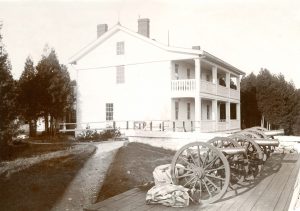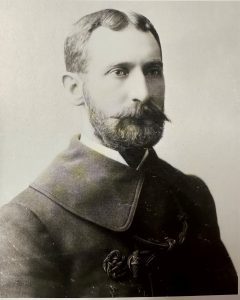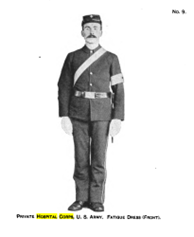For much of the United States’ history, military medicine was the responsibility of a few surgeons. These Post Surgeons would be stationed at forts and posts nationwide. They would travel with campaigning regiments across the country, often with limited supplies and help. These men often held commissions as officers in the army or were given civilian appointments when an army surgeon wasn’t available, as was often the case in Fort Mackinac’s history. Different forts posed different challenges to surgeons depending on the climate of the fort or the condition of the fort buildings and waste systems. This situation would change dramatically during times of war, as the risk of disease and injury increased significantly with a much greater number of soldiers interacting with one another even outside the chaos of combat.

During the Civil War, army surgeons could depend on a complex web of volunteer and charity organizations supplying them with volunteer civilian doctors and nurses (both men and women) to cater to the army’s needs. Both sides would implement formal and informal groups of soldiers to assist in transferring the wounded off the front lines to field hospitals and administering early wound treatment. While many new medical “firsts” can be exhibited during the Civil War in surgery, treatment, and staffing, many of the systems about medical staff went away after the war. Following the war, the army reduced in size, and all volunteer functions disappeared. The peacetime army of the 19th century was chronically under-size, underpaid, and poorly equipped, and the Medical Department faced the brunt of this problem.

In the late 1860s, the army turned its attention west towards the Native Americans of the western plains. For the next 25 years, the army would engage in consistent fighting with several tribes in the final of the “Indian Wars” fought by the United States government against native peoples. This combat required soldiers to be mobile and often to go on campaigns to very remote parts of the country, where supplies for the army were minimal and the hope for help from civilian volunteers extremely slim. Surgeons found themselves to be the sole caretakers for 50-100 soldiers, with the only trained help they might rely on being an enlisted Hospital Steward. Hospital Stewards were specially trained enlisted men, acting more like pharmacists caring for medicine and supplies. This problem also became clear to many commanding officers in combat.
Surgeons typically distanced themselves from the main line of fighting for their safety in battle. In the early stages, they might be seen closer, prepared to move wounded soldiers to the rear, but once casualties began to build up, the wounded soldiers would have to rely on the help of their fellow soldiers to move them to the rear. Commanding Officers found this to be a problem: now, instead of losing one combat-capable soldier, they were losing one to three capable men who should be fighting. Even having a handful of wounded soldiers could seriously inhibit a company, which was often barely at its capacity of 54 men.

Various Surgeon Generals in the early 1880s began advocating for an established group of specially trained soldiers to attend to the soldiers in both combat and garrison situations. On August 11th, 1887, Commanding General Philip Sheridan issued General Order 56, establishing a Hospital Corps. This Hospital Corp included Surgeons, Hospital Stewards, and Privates. Privates were a new addition to the Medical Department. Privates serve directly as assistants to the Hospital Stewards and Surgeons in Garrisons and, in battle, would operate an ambulance and provide care to wounded soldiers. General Order 56 also mandated four soldiers in each company to be “company bearers.” These four men were to be trained regularly on wound treatment and litter bearing and, in an emergency, would help the Hospital Corps.
By November 1887, three privates of the Hospital Corps were stationed at Fort Mackinac, most having transferred directly from the companies already stationed at Fort Mackinac on the recommendation of Assistant Post Surgeon Charles Woodruff. These soldiers would attend division-wide encampments and training, the Corps soon proving themselves to be a valuable and effective part of the army. At Fort Mackinac these men would work regularly in the Post Hospital with sick and injured soldiers and would assist in the training of the company bearers. The Medical Department hoped that by training regular infantry soldiers to be company bearers they could create a consistent recruitment path into the Hospital Corps. Unfortunately, the Hospital Corps was consistently under staffed due to poor pay and negative feelings many soldiers had towards hospital work.
While the Hospital Corps only came into being toward the very end of Fort Mackinac’s time as an active military post, it demonstrates another way Fort Mackinac experienced the changing times of the army. The creation of the Hospital Corps marks a leap forward in military medicine, both in the chaos of the battlefield and the comforts of an army fort. Join us this summer at Fort Mackinac for our new “Medicine at Mackinac” Program. There you can learn more about how medicine was changing and the impact on Fort Mackinac.









